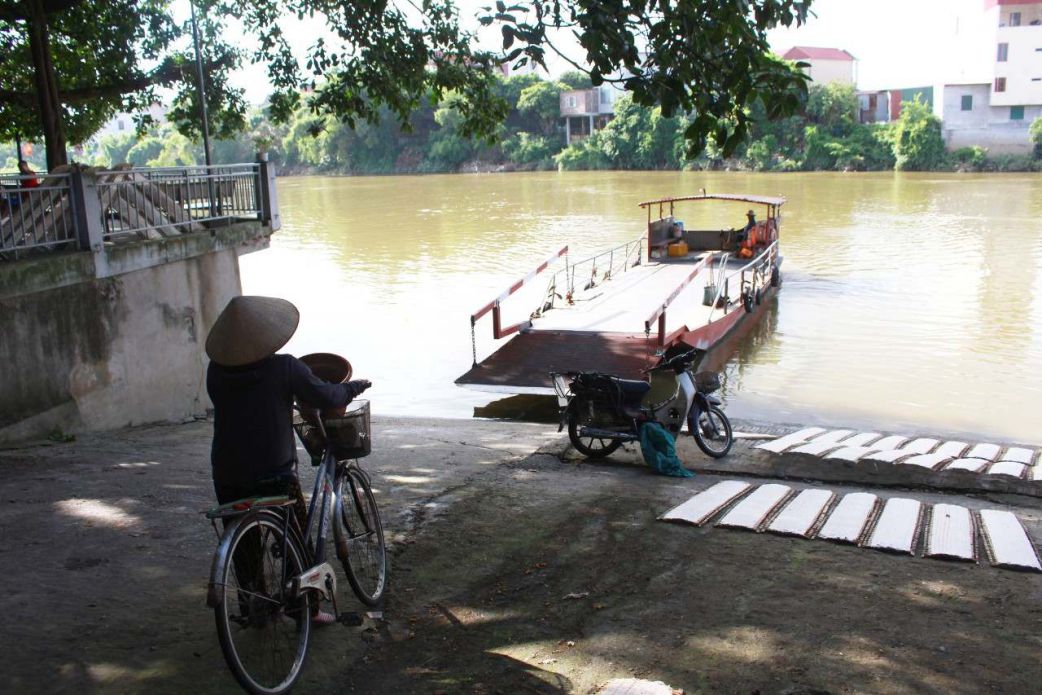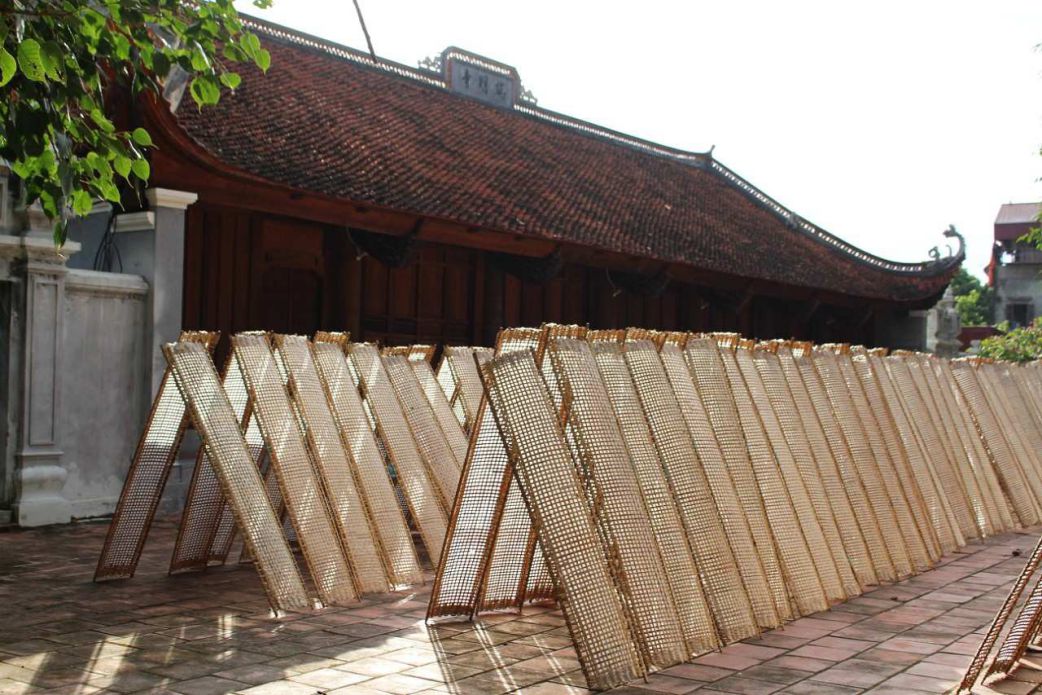"Tho" is land, "Ha" is river, Tho Ha has three sides bordering the river, so the village has three ferry wharfs. From Diem village (Bac Ninh), I went a little further to the ferry across Cau River to Tho Ha village . It's still early, the sun hasn't risen yet. In the lotus ponds, fragrance overflowed.
Approaching the ferry station, I saw many trucks carrying rice cakes from Tho Ha rushing to Bac Ninh. The ferry here is a motorized boat, it keeps coming and going back again and again even though there are few passengers. The river is not too wide, it only takes a few minutes to reach the other side. The green river water continuously laps at the foot of the slope leading up to the village.
As soon as I took my first step into the village, I was surprised. Tho Ha is a village of bamboo panels. From the alleys to the village roads, everywhere you can see rows of fragrant rice paper rolls drying in the sun. Light yellow cake racks are arranged on red walls covered with moss, unintentionally creating a very simple, rural architecture for Tho Ha.
Tho Ha also has many small and deep alleys. Even though it can only fit a couple of people, people still use it to dry rice paper rolls, filling the alley. As a result, the small alley becomes even more ancient, only dimly visible under the rays of sunlight passing through the cake stand, star fruit branches, and grapefruit branches reaching out from the brick wall drenched in green moss. I went in, on both sides were trellises, and when I looked up I saw the trellis covering the top of my head from the sun.

“Tho Ha used to have many professions. Among them is the famous pottery profession. But now there is no more, only the profession of making rice paper rolls still follows people to this day," shared Mr. Nguyen Van Loc - a man over 50 years old who still diligently dries cakes every day. To get batches of smooth, shiny white cakes to dry in the early morning, farmers start work at 2 - 3 am, when the rooster has not yet crowed.
While busy drying the cakes, Mr. Loc pointed me to the gate of Tho Ha village. Tho Ha village gate is one of the most beautiful village gates in the lower and middle reaches of Cau River with ancient architecture. On one side is a pagoda, on the other side is a large lake, and there is a hundred-year-old banyan tree next to it, bringing a unique impression of the culture of the Northern Delta village.
Tho Ha communal house is not far away. The market is held right in front of the communal house, below is a busy ferry wharf. The wind from the river blew coolly. It's been a long time since I've seen such a crowded scene on the dock below the boat. The market here is small, but full of vegetables, meat, fruit cakes... Even though it is crowded and bustling, it is not noisy. Walking around the market, we only hear the sounds of invitations, friendly conversations, or the sound of slurping down bowls of hot, steaming porridge.
I stopped by Mrs. Loc's cat-ear cake shop at the beginning of the market. It's called a "row" but there are only two plastic chairs and a basket with a tray on top to act as a dining table. The cat ear banh khuc here is a small piece, and is not made from cudweed but from hemp leaves or luffa leaves. With many customers, Mrs. Loc was happy, her hands were quick and quick, continuously pouring cakes onto plates.
While enjoying Banh Khuc, I heard more ladies and mothers here chatting happily. Tho Ha village is small, when you go out on the street you meet familiar people. Everyone is very cheerful. The ladies told me that in recent years, the village has had many tourists visit, especially foreigners.
“Everyone returned to the village very happily. They like taking photos at temples and pagodas, experiencing making rice paper, and also love hometown gifts like this," Ms. Loc said.
There are no flashy entertainments, Tho Ha village only has architecture rich in artistic value, or small ancient houses, the house always smells of rice. Throughout the village, from communal houses, pagodas, and riverbanks, baskets of spring rolls are hung to dry, creating sunbursts imprinted on the worn-out brick floors with human footprints. Tourists can freely explore the lifestyle and ancient space of Northern villages.

Under the dark green old banyan tree, there are a few small rows of water for people and tourists to sit and chat and enjoy the cool breeze blowing from the river. I also sat down and rested to wait for the ferry on the other side of the river to return to pick up passengers.
The pace of life here is slow and peaceful. From the leisurely rhythm of the old woman's hands pouring tea, the hands continuously baking coconut rice cakes and cracking crisply on the red fire, or from the footsteps of the women carrying goods at the morning market.
The people and I stood at the edge of the river, quietly waiting for the boat to come. The clouds drifted away from the sun, and the golden sunlight ran from one side of the shore to the other. I remember Mr. Loc's words, people still make rice paper rolls not only to make a living but also to keep their jobs for the village.
I thought to myself that luckily, time has passed, the pace of life has become more hurried, "the banyan tree, the water wharf, the communal house yard" - the beauty that "Northern villages send pictures here" is still there for me to admire. Like many people who traveled long distances across the river to come.
